Table of Contents
Reef Safe Dwarf Angelfish
Generally speaking, all dwarf angels can be kept in a reef tank, and having live rocks is the best environment for them in terms of shelter and foraging. However some inverts should not be introduced to the aquarium as they will tempt the angels to nibble on them.
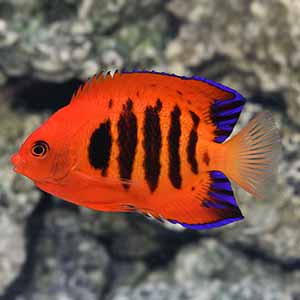
Flame Angelfish
Description
The Flame Angelfish (going by the scientific name of Centropyge loriculus) is one of the most popular dwarf angelfish for beginners and expert aquarists alike. The bold orange/red color, vertical black stripes on the body and blue-tipped fins makes it the centerpiece of any saltwater reef tank.
Reef-Compatibility Cautions
Flame Angels can be kept with invertebrates and corals, but it can nip occasionally on LPS corals, tridacnid clam mantles, zoanthids and soft corals.
- Minimum Tank Size: 30 gallons
- Mature Size: About 4 inches
- Care Difficulty: Moderate
- Diet: Omnivore
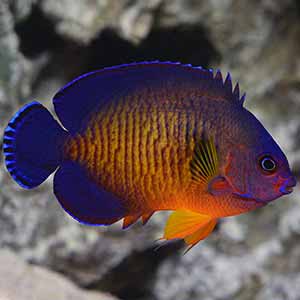
Coral Beauty
Description
The Coral Beauty is another popular saltwater angelfish among hobbyists because it has beautiful colors and it’s also hardy. The colors it has depends on the natural habitat, but common colorations include orange, red or yellow bodies with tails, edges and fins with purple or darker blue shades.
Reef-Compatibility Cautions
The Coral Beauty has a varied dietary need, and that’s why it has been seen eating clams or soft fleshy corals. However this is a case-by-case situation and definitely not the rule. Feeding the fish as often as possible with a variety of food should keep it away from munching on softies or clams.
- Minimum Tank Size: 40 gallons
- Mature Size: About 4 inches
- Care Difficulty: Moderate
- Diet: Omnivore
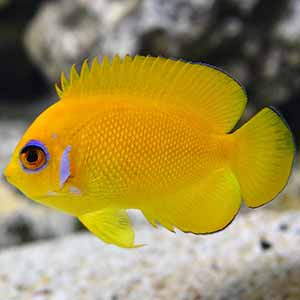
Lemonpeel Angelfish
Description
One of the most gorgeous dwarf angelfish, the Lemonpeel Angelfish has a beautiful color combination that draws all the attention in the reef tank. It has a bright yellow body with sky-blue highlights around the eyes and on the fins.
Reef-Compatibility Cautions
The Lemonpeel Angelfish is a solitary fish and can be aggressive towards other angelfish. If you place two males in a tank they will fight to the death.
This species is known for nipping on tridacnid clam mantles, LPS corals and zoas, therefore you can’t trust it completely when these invertebrates are present in the tank.
- Minimum Tank Size: 30 gallon
- Mature Size: Up to 5.5 inches
- Care Difficulty: Intermediate
- Diet: Omnivore
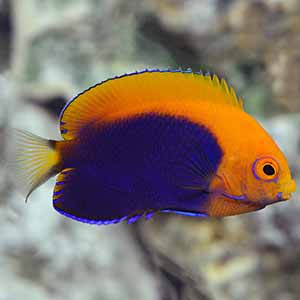
Flameback Angelfish
Description
The Flameback Angelfish (or African Pygmy Angelfish) has striking contrasts of orange-yellow and blue colors. The body color is blue, with a broad orange-yellow patch from the head along the back.
Reef-Compatibility Cautions
This species is some of the most suited for a reef tank aquarium, but cautious should be applied when adding it with meaty brain type corals (Trachyphyllia or Cynarina).
- Minimum Tank Size: 24 gallon
- Mature Size: Up to 3 inches
- Care Difficulty: Beginner
- Diet: Omnivore
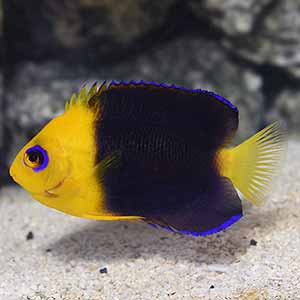
Joculator Angelfish
Description
Another hardy but rare dwarf Angelfish, the Joculator Angelfish can only be found around Christmas Islands and the Cocos. If you are lucky and find this purchase, it will be a great addition to your reef aquarium, especially if you have live rocks in it.
Reef-Compatibility Cautions
While they are not often caught eating corals, the general consensus is that you need to give them frequent and adequate food to keep them from doing it. They will not tolerate their own species or fish with similar coloration.
- Minimum Tank Size: 75 gallons
- Mature Size: 3.5 inches
- Care Difficulty: Intermediate
- Diet: Omnivore
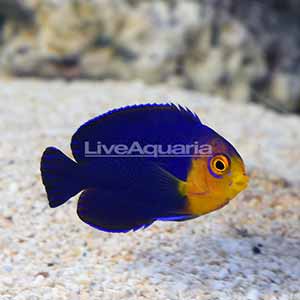
Cherub Angelfish
Description
It is one of the most popular dwarf angelfish, and also the smallest one. Cherub Angelfish is a great addition for small aquariums. It has the same level of aggression as the Flameback Angelfish, therefore you need to keep one per tank.
Reef-Compatibility Cautions
It’s not known for nipping clam mantles or corals, but caution is still recommended when added to a reef tank, as it is a Centropyge Angelfish afterall.
- Minimum Tank Size: 24 gallons
- Mature Size: 3 inches
- Care Difficulty: Beginner
- Diet: Omnivore
Reef Safe Large Angelfish
Among the most popular fish for saltwater aquariums, Large Angels adapt well to captivity. They feed on micro and macroalgae, zooplankton and sponges. Don’t place Angels from the same genus into the same tank because they will fight each other.
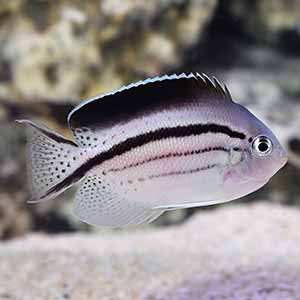
Lamarck’s Angelfish
Description
One of the most docile species from the Genicanthus family, the Lamarck’s Angelfish is a popular choice for aquarists. Despite its size, this fish feeds only on Zooplankton, and doesn’t care about sponges or corals.
Reef-Compatibility Cautions
This fish is an excellent candidate for mixing with corals or other angelfish, but it won’t tolerate other males from the same genus. They might chase smaller planktivores such as Flasher Wrasses, Fairy Wrasses, or Fire Gobies.
- Minimum Tank Size: 125 gallons
- Mature Size: 10 inches
- Care Difficulty: Intermediate
- Diet: Planktivore
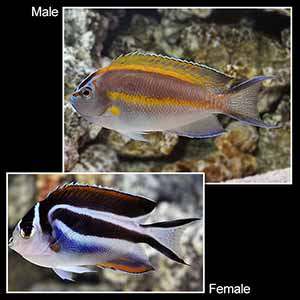
Bellus Angelfish
Description
The Bellus Angelfish is one of the smallest fish of the Genicanthus genus, even though it’s not a dwarf species. The males and females are easily differentiated by the color of the dorsal fin, as males have an orange dorsal fin while females have it black.
Reef-Compatibility Cautions
The Bellus Angelfish are social and thrive in small groups of their own kind, but there should be only one male per tank to not fish each other. They are considered reef safe and not interested in corals.
- Minimum Tank Size: 120 gallons
- Mature Size: 7 inches
- Care Difficulty: Intermediate
- Diet: Omnivore
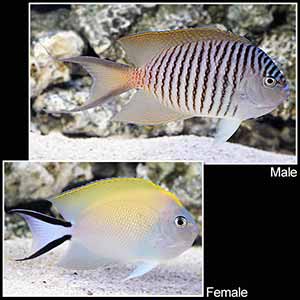
Spotbreast Angelfish
Description
The Spotbreast Angelfish is a beautiful addition to any saltwater, being one of the few fish considered 100% reef safe angelfish. They don’t bother corals, clams or other angelfish.
Reef-Compatibility Cautions
As with other fish from Genicanthus genus, Spotbreast Angelfish males shouldn’t be kept together because they will fight each other. It will ignore other fish species, including non-related angelfish.
- Minimum Tank Size: 125 gallons
- Mature Size: 7 inches
- Care Difficulty: Moderate
- Diet: Omnivore
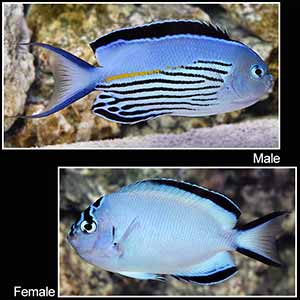
Watanabei Angelfish
Description
The Watanabe’s Angelfish is one of the few angelfish that display sexual dimorphism. The visual difference between males and females is that males have long, horizontal dark stripes on the lower half of the body and the females don’t have stripes. They prefer to be in pairs rather than solitary.
Reef-Compatibility Cautions
Watanabe’s Angelfish eats zooplankton and is known to leave sponges and corals alone. It is considered reef safe in general, but certain fish might start attacking corals and other reef creatures.
- Minimum Tank Size: 100 gallons
- Mature Size: up to 6 inch
- Care Difficulty: Moderate
- Diet: Planktivore
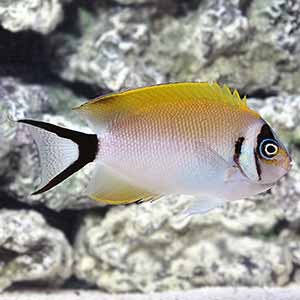
Masked Swallowtail Angelfish
Description
The Japanese Masked Swallowtail Angelfish is a beautiful addition to a reef tank, and it will bring a lot of beauty and personality to it. The males and females are very different from each other, males having a yellow “mask” and black stripes along the body while females have a “black” mask and no stripes. Females can change to males if no dominant male is present, and the change is irreversible.
Reef-Compatibility Cautions
The Masked Swallowtail Angelfish is considered reef safe and will not nip on corals and clams. As with other large angelfish, two males from the same species shouldn’t be placed in the tank or they will fight each other. They can be kept in pairs or with a small harem. You can even put only females in the tank, as one will turn into a male eventually.
- Minimum Tank Size: 100 gallons
- Mature Size: 8 inches
- Care Difficulty: Intermediate
- Diet: Planktivore
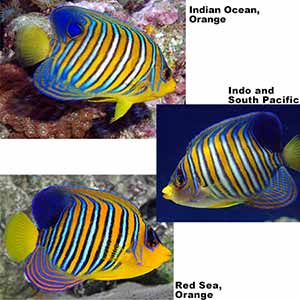
Regal Angelfish
Description
Of all the fish you can keep in a reef tank, the Regal Angelfish is the most beautiful. However it is also one of the most difficult fish to keep for a novice reefer. There is no color difference between males and females.
Reef-Compatibility Cautions
If well-fed, Regal Angelfish don’t nip on corals and other invertebrates in the reef tank. They have a hard time adapting to a reef tank habitat, and that’s why you should always quarantine it until the fish gets used to being fed. The lack of distractions from other fish will help it adapt faster.
- Minimum Tank Size: 100 gallons
- Mature Size: 10 inches
- Care Difficulty: Expert
- Diet: Omnivore
Frequently Asked Questions
Are angelfish okay alone?
Yes, they are quite happy alone, but they prefer to live in a pair. They can also live with other species of fish if they are compatible.
Can you keep two dwarf angels together?
Most dwarf angelfish species are mean, but you can keep two dwarf angels if there’s plenty of room in the tank for both (over 110 gallons). You should also introduce them at the same time to avoid hostility.
Do dwarf angelfish eat algae?
Dwarf angelfish are omnivores, but a large number of species tend to be more herbivorous. Most of them will eat micro and macro algae.
What corals are safe with angelfish?
While leathers and mushrooms are considered safe with angelfish, there’s no guarantee a hungry angelfish won’t try to eat them. The most susceptible corals to be picked on are LPS, brain corals, acans and zoas.
What is the lifespan of a saltwater angelfish?
Angelfish live up to 15 years old, and they might change coloration as they mature.